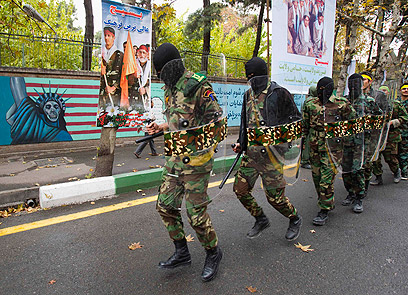
While Iranian leaders are publically dismissing reports of Israeli threats to strike Iran's nuclear facilities, a classified Pentagon intelligence report reveals the state of panic that prevailed in Tehran at a previous time of heightened tensions.
The New York Times reported Wednesday that the Iranian military was so apprehensive about the threat of an Israeli airstrike on its nuclear installations in 2007 and 2008 that it mistakenly fired on civilian airliners and, in one instance, on one of its own military aircraft.
Related stories:
- Ahmadinejad: Iran unfazed by Zionist terrorists
- Op-ed: Why US won't attack Iran
- Iran: Strike a chance to wipe Israel off map
“Iranian air defense units have taken inappropriate actions dozens of times, including firing antiaircraft artillery and scrambling aircraft against unidentified or misidentified targets,” the Pentagon report stated.
It was further noted that the Iranian military’s communications were so inadequate and its training deficiencies so significant that “misidentification of aircraft will continue.”

Iran's Revolutionary Guards (Photo: Reuters)
The report refers to a time when there had been growing concern in Israel and the United States over Iran’s nuclear program and discussion of a military response.
In September 2007, Israeli aircraft bombed a nuclear reactor that was under construction in northeast Syria. The following year, Israel conducted a major air exercise over the Mediterranean that appeared to be a rehearsal for a potential attack on Iran’s uranium enrichment plant at Natanz.
According to the New York Times, Iranian air defense units were edgy, fearing that an enemy aircraft might try to mimic the flight profile of a civilian airliner.
In one instance in June 2007, a Revolutionary Guards air defense unit fired a TOR-M1 surface-to-air missile at a civilian airliner. In May 2008, an antiaircraft battery fired on an Iranian reconnaissance drone and a civilian airliner. That same month, an antiaircraft battery fired on an Iranian F-14 fighter jet.
In June 2008, soon after the Israeli drill, Iranian air defense units fired at two more civilian aircraft. In one instance, an Iranian F-4 fighter scrambled to intercept an Iraqi Airways flight from Baghdad to Tehran to visually inspect the passenger plane. The Iraqi Airways plane was not harmed.
The NYT noted that the Pentagon report was examined for a new book. It suggests that the Iranian military started training for an attack in the summer of 2008.
Less than two weeks after the Israeli drill, the commander of the Iranian Air Force ordered fighter units to “conduct daily air-to-ground attack training (GAT) at firing ranges resembling the Israeli city of Haifa and the Israeli nuclear facility at Dimona,” according to a classified 2008 report by the Defense Intelligence Agency.
Iraqi concern
Iraqi officials had their own concerns about a possible Israeli strike, the NYT said. On July 3, 2008, Prime Minister Nuri Kamal al-Maliki of Iraq opened a videoconference with President George W. Bush by expressing his fear that Israel might fly through Iraqi skies to attack Iran.
If Israel violated Iraqi airspace, he said, he would have no choice but to hold the United States responsible, said Mr. Maliki, who said that he could not allow Iraq to “become a battleground.”
“I hear you loud and clear,” Mr. Bush assured Mr. Maliki, according to notes of the conversation. “Nothing is more important to me than success in Iraq.”
- Receive Ynetnews updates
directly to your desktop















